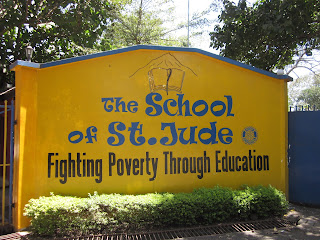Today (written on 1st Feb) we went to St Jude’s school- Africa’s largest charity funded school providing education to over 1500 students for free. The young founder and director Gemma Rice (now Gemma Sisia) is a sheep farmer’s daughter, from Australia who believes in “Fighting Poverty Through Education” and is the brains and determination behind this great achievement.
Yesterday, 31st January 2012, the School celebrated 10 years since opening its first classroom in 2002, when there was one teacher and 3 students. They now employ over 150 Tanzanian teachers and 250 support roles across 3 campuses. With a 40km radius of catchment area to each school, there are also boarding facilities for 1000 students
The students qualify for entry to St Jude’s by possessing strong academic potential, whilst coming from impoverished backgrounds. Only one child per family is permitted in order to ensure fairness and to perpetuate the opportunities far into each community.
When we arrived we were greeted by Helen, an Aberdonian who had taken an 18 month voluntary administration post, and was clearly moved by the great opportunity she had been given. After a brief introduction to St Jude’s we were taken up to the upper school’s dining hall and invited to join everyone for lunch. Just as we arrived the bell sounded and the young students poured out of every visible door, and filed across the grass and to the long lines of tables where they took their place for grace. St Jude’s places great importance on meal times, as they are acutely aware that it may be the only nourishment the children receive that day.
We joined on the end of the table, where the children welcomed the visitors, in English. One rule for visitors to St Jude’s – you must speak in English to the children! This is a lot easier said than done, when all we had been doing for the past 2 weeks was mastering Kswahili! But the children soon corrected us, and they were far more fluent in their English than me in Kswahili, and keen to converse with the visitors.
After lunch was play time, but our new friends were keen to show us around and ask lots of questions about who these visitor were and where they came from. My new friend Nickson was keen to show me the art room and his replica multicoloured St Jude’s school bus. Afterwards, the conversation turned to reading, and Nickson thought Roald Dahl was simply brilliant! When the school bell sounded again, the children dutifully dispersed back to the classrooms for afternoon session, without too much complaint.
 |
| RAFIKI NICKSON |
Adela then joined us to complete our tour, which took us via a well stocked library in the upper school and two modern PC rooms, and numerous classrooms where only a handful of students were distracted enough to wave, most continued studiously. On the front a PE lesson was taking place with a volunteer from the USA leading class. Jo and I were keen to join in, and thought we were doing pretty well until the children gingerly pointed out that our throwing technique was entirely wrong, and made us start again!
 |
| MISS GUILFOYLE LOOKING VERY ATTENTIVE IN CLASS |
 |
| A TYPICAL CLASSROOM IN JUNIOR SCHOOL |
 |
| PE CLASS |
 |
| THE COLOURFUL ST JUDE'S SCHOOL BUSES |
Soon the school bell signalled the end of another day. Helen sought us out and offered us a lift home on the school bus going close to the Work the World house. As we boarded the slightly over crowded bus, the children were all too pleased to scrunch up or sit on our knees to make room. Their excited chatter lasted the whole journey. When the bus first stopped we had arrived in the small impoverished villages which perhaps could be called slums. There was order in the villages which had small houses with winding pathways between each row, but the conditions were far from ideal, and there was no electricity here. It wasn’t entirely removed of beauty as I pointed out the pretty lake surrounded by flowers and asked the children if they ever swam there. They burst into hysterics and replied that this was “a pool for poopies”!
 |
| ON THE SCHOOL BUS HOME |
In all seriousness though, it was this part of the day more than any other that struck me just how special St Jude’s school is. There was a stark contrast from the handsome school, its new books, the PC suites and the smartly dressed children, to this home life. St Jude’s relies entirely on donations, which were buying not just the tools to educate and empower these young people but to give each and every child back the chance to dream.
Every child I spoke to at St Jude’s had a dream. These were dreams of future careers, or further education, or of foreign travel, and all these dreams are made entirely possible, by the hard work and dedication of all the staff and volunteers who continue to make St Jude’s a success for generations to come.
Thank you so much for this amazing insight.


















































